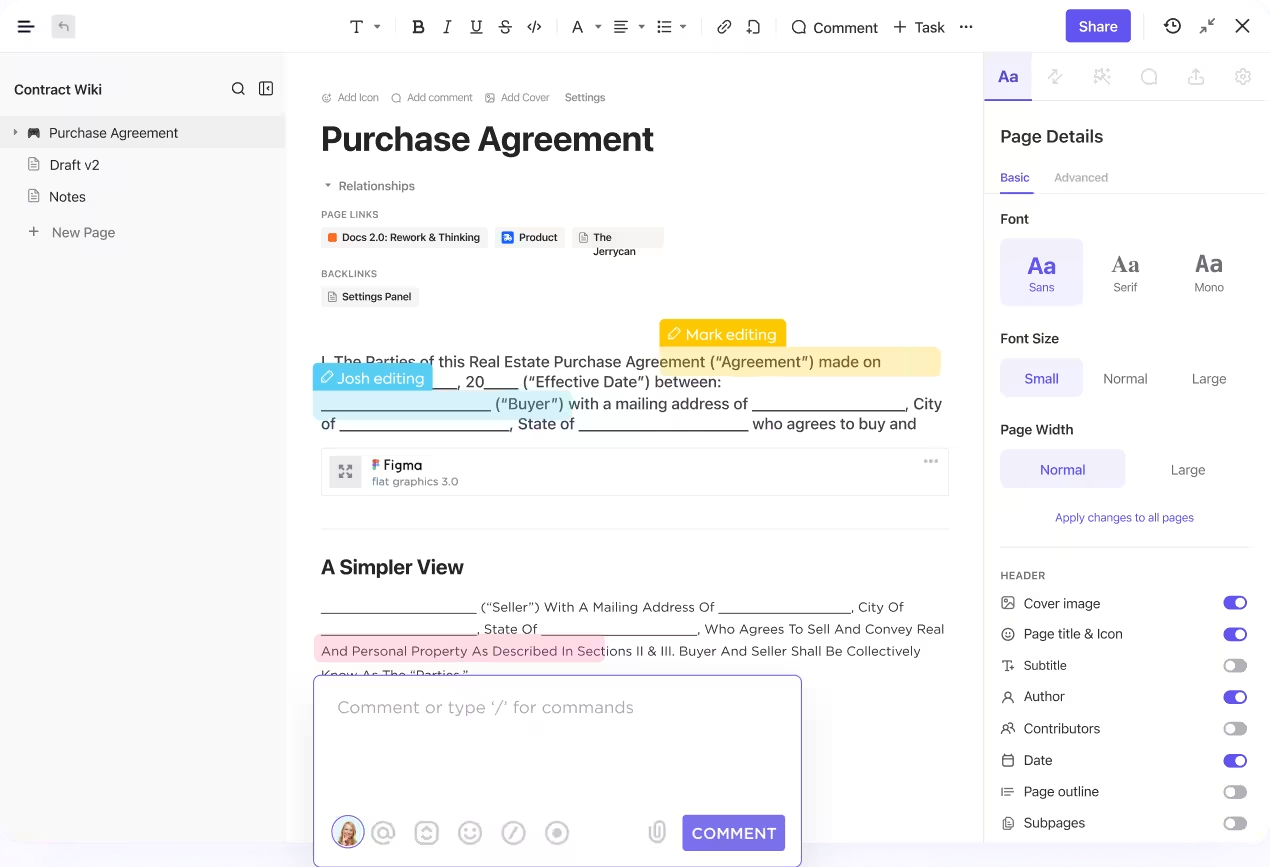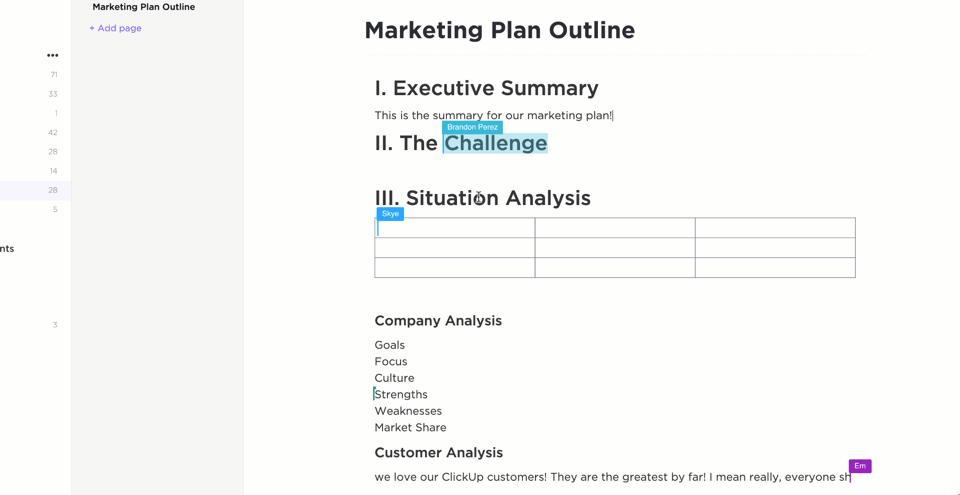How to Make a Template in Google Docs

Sorry, there were no results found for “”
Sorry, there were no results found for “”
Sorry, there were no results found for “”

Have you ever found yourself repeatedly formatting the same types of documents in Google Docs?
Whether you’re drafting a monthly project report, preparing a syllabus, or setting up a standard meeting agenda, starting from scratch each time can be exhausting.
What if you could skip this repetitive setup?
Google Docs templates are the key!
👋 Say goodbye to tweaking margins and headers over and over with this guide. We’ll show you how to make a template in Google Docs. We’ll also cover how to manage your template repository and introduce you to a better way to save time and ensure consistency across your documents.
You create a template by starting a new document or modifying an existing file, adding placeholders, saving it with a unique name, and submitting it to the Template Gallery. Once approved, the template becomes reusable across your organization. This process allows basic standardization but relies heavily on manual setup.
To begin creating your template in Google Docs, visit the Google Docs website. Open a new Google Docs file directly or navigate through your Google Drive to find the document you wish to convert into a google Docs template.
Here’s a step-by-step approach to how to create a template with your personal Google account:

Open your Google Workspace account. Navigate to your Google Docs home page.
Under “Start a new document,” select the “Blank document” template to start fresh.
Alternatively, if you want to convert existing document into a template file, open it, make any necessary modifications, and then save it under a unique title to differentiate it from the original.

Once you’ve opened Google Docs and accessed the document you need, customize it to your needs. This could involve adding specific text, formatting headers, or inserting placeholders for frequently changed content.
For placeholders, consider using markers like [TK name of dog] or [XX date], which are easy to search for and replace later.
After setting up your document with all the necessary placeholders and content:
Note: If you’re using Google Workspace, your template document will automatically be saved as you make the changes.
To make your template accessible to others in your organization:

To find and use your newly created template:
📖 Bonus Read: Free Knowledge Base Templates in Word & ClickUp
Creating templates in Google Docs can significantly streamline repetitive tasks, but some limitations exist. Here are a few of them:
📖 Bonus Read: Top Google Docs Cover Letter Templates for 2024
ClickUp Templates overcome Google Docs’ limitations with dynamic fields, conditional logic, and strict standardization. Templates can be built from Tasks, Docs, or full project structures. Teams get stronger control over sharing, reuse, and consistency across workflows.
ClickUp is the perfect Google Docs alternative for overcoming the limitations commonly encountered with content tools. ClickUp Templates also offer a robust, ready-to-use solution for building and deploying templates.
With advanced features like dynamic fields and conditional formatting, ClickUp templates adapt and respond to specific data inputs, enhancing document functionality and interactivity. Our platform enforces template standardization to ensure consistent formatting across all documents.
ClickUp supports custom templates while offering extensive template sharing and control options. This is how you can ensure secure use within and outside an organization.
With ClickUp Templates, you can:
💡 Pro Tip: Organize complex information and streamline project planning by incorporating Mind Map templates into your workflow
Here’s how to create your custom template using ClickUp Templates:
Start by navigating to the item within your ClickUp Workspace that you want to turn into a template. This could be anything from a Task setup to a project plan or a Doc.
Click the ellipsis (…) to open the settings menu for the item you’ve selected. From here, choose ‘Templates’, then ‘Save as Template’.

This creates a template from any existing Workspace item, providing a base that includes timelines, assignees, and important details.
Customizing your template goes beyond just naming and tagging.
Once you’ve chosen a template from the Template Center, you can customize it according to your needs. Under ‘Update Existing Template’, you can decide exactly which elements of the template you want to apply.

Utilize the Template Center to organize your templates. Apply Tags, filter by department or creator, and even add preview images to indicate the template’s purpose.
This capability ensures your templates are easily accessible and manageable across your team or organization.
ClickUp allows for the remapping of dates when applying templates, a significant upgrade over the static nature of Google Docs templates.
When you apply a Space, Folder, or List template, you can keep the original start and due dates or adjust them to fit the new project timeline.
This feature is particularly useful for project management, ensuring deadlines are always relevant to the project’s timeline.
Templates in ClickUp can be kept private or shared with others inside or outside your workspace. This flexibility starkly contrasts with Google Docs, where sharing and permissions can be limiting.
📖 Bonus Read: How to Create a Fillable Form in Google Docs
📮ClickUp Insight: Low-performing teams are 4 times more likely to juggle 15+ tools, while high-performing teams maintain efficiency by limiting their toolkit to 9 or fewer platforms. But how about using one platform?
As the everything app for work, ClickUp brings your tasks, projects, docs, wikis, chat, and calls under a single platform, complete with AI-powered workflows. Ready to work smarter? ClickUp works for every team, makes work visible, and allows you to focus on what matters while AI handles the rest.
ClickUp Workspace offers numerous features to enhance your template creation process. Let’s look at some:

ClickUp Docs offers a seamless environment for creating, managing, and sharing documents, all of which are interconnected with your workflows.
Create and manage all your documents, wikis, and more in one place. Seamlessly integrate your documents into workflows to execute ideas efficiently. With ClickUp Docs, you can:

ClickUp Brain is a robust AI integration designed to automate and enhance task management and templates.
ClickUp Brain leverages advanced machine learning algorithms to understand your workflows and provide predictive analytics, suggesting when to create or modify new templates to keep your processes efficient. It helps you:
Bonus: How to Create a Family Tree on Google Docs!
It’s crucial to consider the template creation tool’s versatility, integration capabilities, and ease of use. ClickUp excels in all these areas, offering a comprehensive workspace that seamlessly integrates documents, tasks, and external data.
Unlike other platforms, such as Google Docs templates, ClickUp connects with CRMs and other tools, ensuring that all project components are synchronized and easily accessible within a single workspace.
ClickUp goes beyond simple template creation by providing advanced features like dynamic fields, smart placeholders, and robust template management options, which are crucial for maintaining consistency and accuracy in your documents.
Ready to revolutionize how you create and use templates?
Give ClickUp a try and experience a more connected and efficient way to manage your projects and workflows. Sign up with ClickUp today.
© 2026 ClickUp